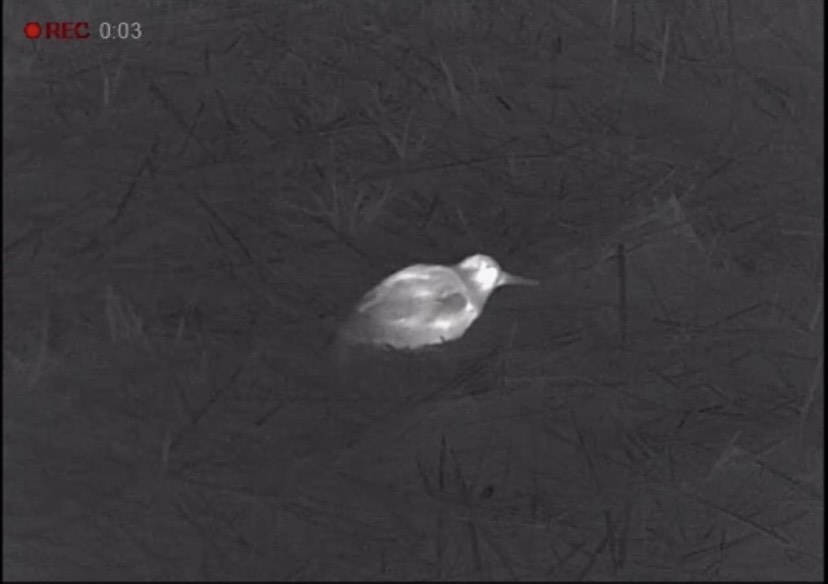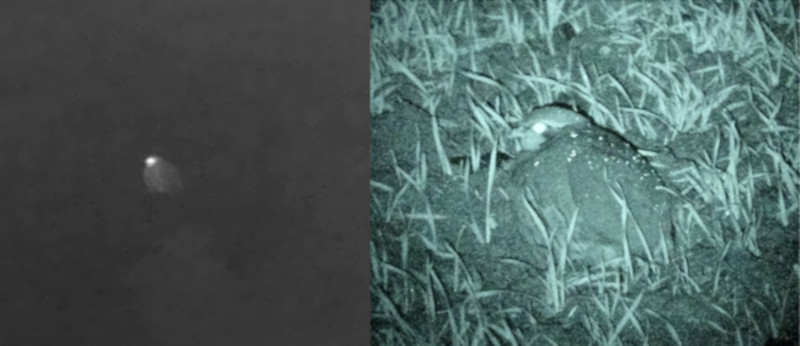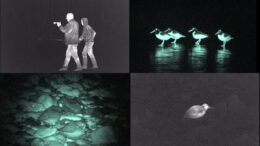In April 2016, among the spring blossoms in the West Midlands of England, an idea came to Ben Dolan and Paul Hopwood. As certified ringers belonging to the West Midlands Ringing Group — volunteers who mark birds’ legs with bands and unique ID numbers so that researchers can study and track them over time — they were out looking for lapwing chicks. Although they’d managed to find 10 or so birds by eye, others eluded them. Thinking there had to be a better way of locating the chicks, Dolan and Hopwood wondered if thermal imaging might allow them to find birds based on their body heat.
They returned another afternoon with a borrowed thermal camera in hand and tried it out. This time they found more than twice as many of the baby birds.
Inspired, they acquired access to a thermal camera they could use regularly and, the following winter, decided to try using the technology at night.
It was during these dark winter days that they realized how useful thermal could really be.

Dolan says thermal imaging can help solve an important conservation problem: If field ecologists don’t see wildlife when they survey during the day, they can declare fields ecological wastelands, leaving the regions open to development without the relevant mitigation strategies to reduce harm to native species.
“And then on the night, we find at times significant numbers of winter migrants utilizing the fields for feeding and roosting,” he says. “So it’s a bit of a worry when daytime surveys are done and nothing of ‘value’ is found, and then on the night we find that actually it is one of the most valuable fields [for local wildlife].”
Recent ecology reports state there’s nothing of value on this land because they’ve surveyed it during the day. We need to understand the value of land at night. Over 50 Jack Snipe, 100 Common Snipe, 20 Lapwing, 30 Skylark & 4 Golden Plover on this land at night #thermalwildlife pic.twitter.com/qJGhrJpeTT
— West Midlands Ringing Group (@RingersWm) November 23, 2021
Waking Up to the Nocturnal
Since they embraced the technology, the West Midlands Ringing Group — which Dolan and Hopwood help run — has pushed the use of thermal imaging for the study of farmland birds. In 2021 they won an award for pioneering the use of the technology in the field.
And it’s not just birds, either: Running ecological surveys, people routinely ignore the needs of all kinds of animals that are active at night.
This bias toward animals who share our circadian rhythm is common throughout the ecological sciences. As it stands, there’s no comprehensive field of study dedicated to nocturnal animals. With up to 30% of vertebrates and 60% of invertebrates predicted to be nocturnal, however, this leaves a massive gap in our understanding of the biosphere — a strange problem to accept in the ongoing global mass extinction.
The lack of study in nocturnal ecology isn’t necessarily due to a lack of trying. More than 70 years ago, American ecologist Orlando Park identified the need to deal with the “nocturnal problem” — to recognize and understand the different needs of nocturnal animals. Even though some humans may consider themselves night owls, human bodies are not really adapted for life under the moon. And that’s always made the study of nocturnal animals difficult.
Recovery: Woodcock, originally ringed at The Bradshaws, Staffordshire on 22/12/2019 has been reported shot 5km away Jan 2022. These birds are still shot in the UK despite being a red listed species. From what we know this bird may have flown over 14,000 miles on migration alone. pic.twitter.com/2ZBhlBlTpd
— West Midlands Ringing Group (@RingersWm) February 5, 2022
So how did we study animals at night when we couldn’t even see them properly?
“You just kind of had to infer what animals had done at night based on what you could see, like counting footprints or seeing some of the marks they left behind,” says Wesley Payne, a Ph.D. student in ecology at the University of Hull in Yorkshire, England.
Like the West Midlands Ringing Group, Payne has been using thermal imaging to study the nocturnal behavior of over-wintering waders as part of his doctorate.
“Essentially, thermal just makes it much easier to find whatever you’re looking for,” he says.
Thermal also has some benefits for the birds.
“You’re reducing disturbance because you’re not walking all over the field,” says Dolan. “You can actually see these birds from quite a distance.”
And the benefits of thermal extend far beyond the avian world. Zoologist Priscillia Miard, founder of the Night Spotting Project in Malaysia, has used it to study nocturnal mammals like the slow loris. She has had similar experiences to Dolan’s and Payne’s and says thermal has provided new insights.
“A lot of things we thought about [slow loris] were actually wrong,” she says. “They are more social than we thought, so it really helped research specific behaviors.”
View this post on Instagram
Spreading the Science and the Benefits of Volunteerism
Communicating how thermal has improved their fieldwork has now become a key part of the Ringing Group’s mission. They work directly with other volunteer groups and landowners in England to show them how to use thermal imaging and have set up a global network of interested ringers.
Recovery: Goldfinch, originally ringed on 21/03/21 @handles4forks has been re-caught on 19/04/22, 323km away at Leswalt, Dumfries & Galloway pic.twitter.com/K6DY85CnVP
— West Midlands Ringing Group (@RingersWm) May 13, 2022
Volunteer ringers play essential roles in conservation. Driven by a passion like birdwatching, they often act as citizen scientists and collect data over many years in their local areas. Professional ecologists, on the other hand, are paid to run surveys to determine the worth of land. This has to be done if someone wants to convert that land to agriculture or housing, for example. The ecologist’s job is to come up with mitigation strategies for protecting local wildlife.
These may appear to serve different roles, but the Ringing Group has started to build a presence in the scientific community, showing that the lines between groups can sometimes blur.
Looking forward to giving a talk to Oxford Ornithological society on Thermal Birding tonight. It’s been an incredible journey and we love sharing our experiences with others. @ThomasJacksLtd pic.twitter.com/WJp98dsUmh
— West Midlands Ringing Group (@RingersWm) April 13, 2022
“We’ve written our first paper on thermal and submitted it, and we’re going to write several more as well,” Dolan says. “If you look at academia, there’s not a lot around about thermal imaging for this type of work, so it’s an opportunity for us to share even further.”
Heat Gaps
Even with its wide array of benefits, most ecology companies still don’t seem to be picking the technology up.
“I’m personally not aware of any consultancies that are introducing it as standard practice for breeding and wintering bird surveys,” says Jess Stuart-Smith, an associate ecologist at Focus Environmental Consultants, based in Worcester, England. They use thermal, she says, for studying bats and other consultancies might use thermal for completely nocturnal species, but there are no guidelines for studying birds who may use different land depending on the time of day. Her first experience of using thermal in this capacity came through volunteering for the Ringing Group, and she has slowly been introducing it into her professional work.
Stuart-Smith suggests a lack of awareness explains why nocturnal surveys haven’t become standard practice yet.
“My long-term goal is to get some actual guidelines out there for wintering bird surveys that people can use and implement because you just get a better-rounded picture of land use if you’re looking at it at nighttime as well as daytime,” she says.
But there are also limitations associated with thermal. Miard says research-grade thermal equipment can cost up to $2,000 — an outlay many research-funding agencies aren’t willing to make.
“I think people are interested in thermal, but the price is a big factor that a lot of people here cannot afford,” she says.
Another downside is that the data retrieved can often be quite poor. “What I get mostly is a silhouette of the bird, which has some variation in color, but it can be difficult to tell the species apart,” says Payne.
Where people can’t get close enough to the animal they’re studying — for geographical reasons, for example — thermal becomes less useful. “If you get a dense group of birds, you can’t tell them apart. You just get one blob of heat, because all of the thermal signatures overlap.”
To gather better data, Payne has started using thermal in combination with infrared imaging. Although both technologies detect infrared radiation, they do so at different frequencies, which means the data they generate is completely different. Infrared provides a much more detailed picture of the birds being studied, making it easier to accurately assess the species.

Even so, it’s still a lot harder to find the birds using infrared, as it provides less contrast between the animals and their surroundings than thermal. In that way, the technologies complement one another: One can be used to find the birds, where the other gives more accurate information.
Following his own experience of nocturnal ecology, Payne says the field has a brighter future.
“I think it’s going to grow as equipment becomes cheaper and more portable,” he says. “I really hope it’s going to help conservation and maybe make it more targeted, so that any money going in focuses on where it’s actually going to be most important.”
Meanwhile, Dalton hopes that their work at the Ringing Group shows the value volunteer groups can bring to conservation.
“What we’d like to see is ecology companies, when they speak to landowners, ask if they have volunteer groups on your land surveying? And can you link us with them?” he says. “Groups like ours can offer a hell of a lot to ecology companies — we have that baseline data, which they haven’t got.”
Stuart-Smith has similar thoughts.
“At the end of the day, we’re all doing it for the same goal,” she says. “It’s all about biodiversity net gain. It’s absolutely critical that we’re all interacting with one another.”
Previously in The Revelator:
![]()


